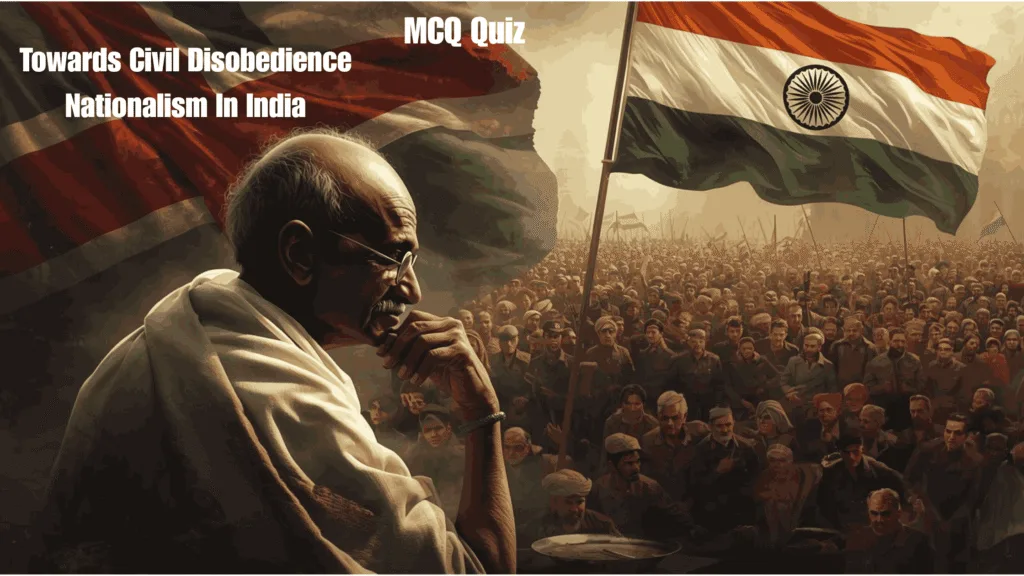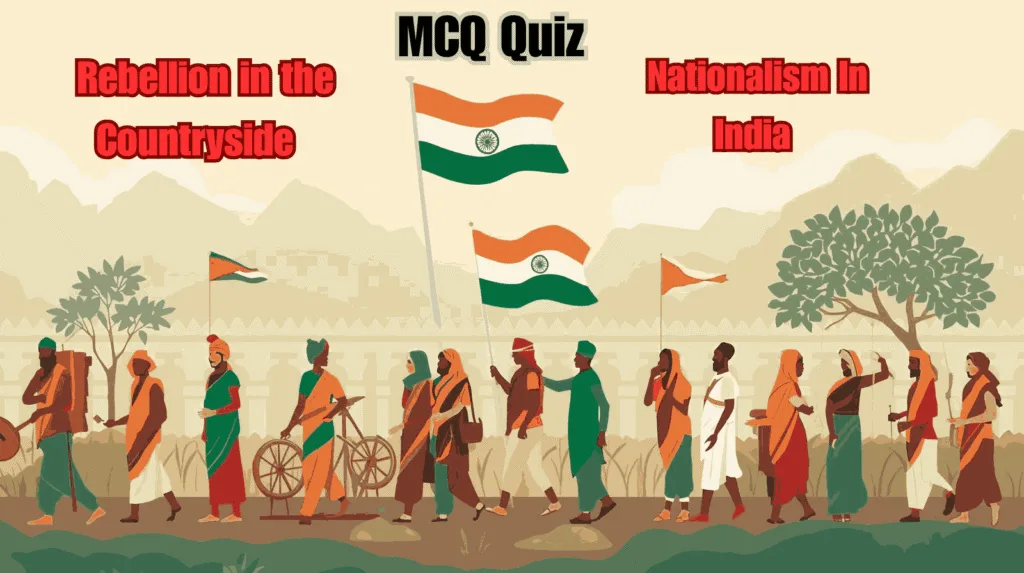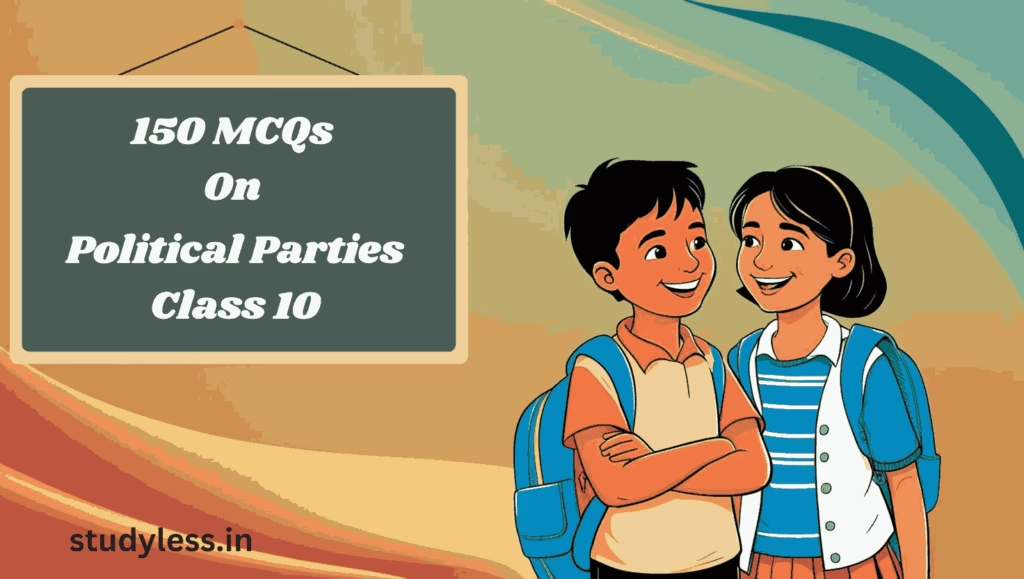Are you ready to ace your Class 10 Federalism chapter?
Well, you’re in the right place! We’ve put together 100 fully conceptual Federalism MCQs that cover every nook and corner of Federalism – perfect for mastering this important topic for your CBSE exams.
Whether you’re looking to brush up on key concepts or challenge yourself with tricky questions, this collection has got you covered.
From the basics to advanced questions, we’ve carefully crafted these MCQs to help you gain a deep understanding of Federalism and tackle your exams with confidence.
Ready to dive in? Let’s go! 💡
Table of Contents
![Federalism MCQs [100] Class 10 Cbse, Fully Conceptual, You can't Miss It!](https://studyless.in/wp-content/uploads/2025/04/fed3image.avif)
📘 Section 1: Basics of Federalism (Q1–Q20)
1. What is federalism?
(a) Rule by a king
(b) Power is divided between central and state governments
(c) Only the central government holds power
(d) Rule by local bodies
2. In a federal system, power is divided between:
(a) People and government
(b) Central and state governments
(c) Judiciary and Parliament
(d) PM and President
3. Which of these is a feature of federalism?
(a) Only one government
(b) Sub-units can’t make laws
(c) Power sharing between levels
(d) Dictatorship
4. A unitary system means:
(a) All power is with the judiciary
(b) All power is with central govt
(c) States have equal power
(d) Two levels of government
5. Which of the following countries is NOT a federation?
(a) India
(b) Belgium
(c) Sri Lanka
(d) USA
6. Which of the following is a ‘coming together’ federation?
(a) India
(b) Belgium
(c) Spain
(d) USA
7. In a ‘holding together’ federation:
(a) States come together voluntarily
(b) Central government shares power with states
(c) States can secede
(d) None of the above
8. India is described as a ‘Union of States’ because:
(a) States are independent
(b) States are temporary
(c) States don’t have their own laws
(d) It emphasizes unity of the nation
9. Which country shifted from unitary to federal in 1993?
(a) India
(b) USA
(c) Belgium
(d) Sri Lanka
10. The number of federal countries in the world is around:
(a) 50
(b) 25
(c) 75
(d) 193
11. Which feature is essential for a successful federation?
(a) Economic equality
(b) Mutual trust
(c) Common language
(d) Same religion
12. The term “jurisdiction” refers to:
(a) Area under rainfall
(b) Area under legal authority
(c) Area under irrigation
(d) None of the above
13. In federalism, each government tier has:
(a) Equal population
(b) Its own police
(c) Its own area of jurisdiction
(d) No separate powers
14. A key characteristic of federalism is:
(a) Division of wealth
(b) Division of caste
(c) Division of power
(d) Division of labor
15. The Belgian model gave powers to regions in:
(a) 1947
(b) 1971
(c) 1993
(d) 2000
16. In India, the tier below State government is called:
(a) District Council
(b) Local government
(c) Central Secretariat
(d) Zonal body
17. Which of these countries follow ‘holding together’ model?
(a) Australia
(b) Switzerland
(c) India
(d) USA
18. Which country is NOT a federal country?
(a) Pakistan
(b) China
(c) Brazil
(d) Canada
19. The Constitution of India distributes power between:
(a) State and Panchayat
(b) Union and State
(c) PM and President
(d) Village and City
20. What does federalism promote?
(a) Centralisation
(b) Monarchy
(c) Unity and diversity
(d) Dictatorship
✅ Answer Key: Federalism MCQs 1–20
| Q. No | Ans | Q. No | Ans | Q. No | Ans | Q. No | Ans |
|---|---|---|---|---|---|---|---|
| 1 | B | 2 | B | 3 | C | 4 | B |
| 5 | C | 6 | D | 7 | B | 8 | D |
| 9 | C | 10 | B | 11 | B | 12 | B |
| 13 | C | 14 | C | 15 | C | 16 | B |
| 17 | C | 18 | B | 19 | B | 20 | C |
⚖️ Section 2: Federalism in India (Q21–Q40)
21. What kind of structure does the Indian Constitution provide?
(a) Unitary
(b) Federal
(c) Dictatorial
(d) Monarchial
22. The three lists in the Indian Constitution are:
(a) Primary, Secondary, Tertiary
(b) Government, State, Civil
(c) Union, State, Concurrent
(d) Civil, Political, Economic
23. Which of the following is not in the Union List?
(a) Defence
(b) Currency
(c) Police
(d) Foreign Affairs
24. Which of the following falls under the State List?
(a) Banking
(b) Education
(c) Police
(d) Communications
25. Concurrent List includes:
(a) Agriculture
(b) Currency
(c) Foreign Affairs
(d) Marriage
26. If there’s a conflict between Union and State laws on a concurrent subject:
(a) State law prevails
(b) Union law prevails
(c) Judiciary decides
(d) Both laws become invalid
27. Residuary powers belong to:
(a) State Government
(b) Union Government
(c) Local Government
(d) Judiciary
28. Which Article provides special provisions for North Eastern states?
(a) 350
(b) 370
(c) 371
(d) 356
29. The Union Government can make laws on ‘residuary’ subjects because:
(a) It is more powerful
(b) It is older
(c) Constitution gives it power
(d) States allow it
30. Subjects like software development fall under:
(a) Union List
(b) State List
(c) Concurrent List
(d) Residuary List
31. In India, all states do not have:
(a) Equal territory
(b) Equal languages
(c) Equal representation
(d) Equal powers
32. Article 371 protects:
(a) Land rights of indigenous people
(b) Voting rights
(c) Fundamental duties
(d) Citizenship rights
33. Which of these is a Union Territory?
(a) Sikkim
(b) Goa
(c) Nagaland
(d) Chandigarh
34. Who can change the federal structure of India?
(a) President
(b) Parliament with state consent
(c) Lok Sabha alone
(d) Prime Minister
35. Who interprets power-sharing in case of dispute?
(a) Prime Minister
(b) Governor
(c) Supreme Court
(d) President
36. Revenue sources for each level of government are:
(a) Common
(b) Undefined
(c) Clearly specified
(d) Controlled by PM
37. What prevents Union Govt from dismissing State Govts arbitrarily?
(a) President
(b) Parliament
(c) Judiciary
(d) Police
38. Which list includes education?
(a) Union
(b) State
(c) Concurrent
(d) Residuary
39. States like Nagaland enjoy special status due to:
(a) Climate
(b) Location
(c) Cultural & historical reasons
(d) Economic status
40. The Constitution of India uses which term for the country?
(a) Republic of States
(b) Federal Union
(c) Union of India
(d) United Provinces
✅ Answer Key: Federalism MCQs 21–40
| Q. No | Ans | Q. No | Ans | Q. No | Ans | Q. No | Ans |
|---|---|---|---|---|---|---|---|
| 21 | B | 22 | C | 23 | C | 24 | C |
| 25 | D | 26 | B | 27 | B | 28 | C |
| 29 | C | 30 | D | 31 | D | 32 | A |
| 33 | D | 34 | B | 35 | C | 36 | C |
| 37 | C | 38 | C | 39 | C | 40 | C |
🌍 Section 3: Federalism in the World – Compare & Contrast (Q41–Q60)
41. The USA is an example of which type of federation?
(a) Holding together
(b) Coming together
(c) Disintegrated
(d) Parliamentary
42. Which of the following is a ‘holding together’ federation?
(a) Australia
(b) India
(c) Switzerland
(d) USA
43. In a ‘coming together’ federation:
(a) States lose independence
(b) Central govt is more powerful
(c) States retain identity and power
(d) No power-sharing
44. Which of these countries has equal powers for all states?
(a) India
(b) Belgium
(c) USA
(d) China
45. The federal structure of the USA is designed to:
(a) Strengthen monarchy
(b) Avoid division of power
(c) Promote unity and individual state rights
(d) Establish one-party rule
46. The word ‘federal’ comes from:
(a) Latin
(b) Greek
(c) French
(d) Sanskrit
47. In a federal system, who is the final interpreter of the Constitution?
(a) President
(b) Supreme Court
(c) Prime Minister
(d) Home Minister
48. Which of these countries practices unitary government?
(a) Sri Lanka
(b) Canada
(c) Brazil
(d) Russia
49. What makes Belgium different from Sri Lanka in power-sharing?
(a) More dictatorship
(b) More decentralisation
(c) Less democracy
(d) No state governments
50. The central government in a unitary system can:
(a) Dismiss state laws
(b) Override regional powers
(c) Withdraw state powers anytime
(d) All of the above
51. In the Belgian model, regional governments got powers in:
(a) 1983
(b) 1993
(c) 1975
(d) 2001
52. How many countries in the world officially follow federalism?
(a) 193
(b) 150
(c) 25
(d) 60
53. Federation means:
(a) Rule by army
(b) Rule by king
(c) Sharing of power between central and regional govts
(d) No rule at all
54. Germany, USA, and Australia are examples of:
(a) Unitary governments
(b) Dictatorships
(c) Coming together federations
(d) Monarchies
55. Which country provides equal power to its constituent states?
(a) Belgium
(b) Switzerland
(c) India
(d) Pakistan
56. In which federation are regional governments more powerful?
(a) Holding together
(b) Unitary
(c) Coming together
(d) Hybrid
57. In a unitary system, the provincial governments are:
(a) Autonomous
(b) Equal
(c) Subordinate
(d) Supreme
58. Which among the following is NOT a feature of a federal country?
(a) Two levels of govt
(b) Power-sharing
(c) Same laws for all areas
(d) Decentralisation
59. Which type of federalism allows different states to have unequal powers?
(a) Unitary
(b) Holding together
(c) Coming together
(d) Dictatorship
60. Which of the following practices decentralisation most extensively?
(a) Sri Lanka
(b) Canada
(c) India
(d) China
✅ Answer Key: Federalism MCQs 41–60
| Q. No | Ans | Q. No | Ans | Q. No | Ans | Q. No | Ans |
|---|---|---|---|---|---|---|---|
| 41 | B | 42 | B | 43 | C | 44 | C |
| 45 | C | 46 | A | 47 | B | 48 | A |
| 49 | B | 50 | D | 51 | B | 52 | C |
| 53 | C | 54 | C | 55 | B | 56 | C |
| 57 | C | 58 | C | 59 | B | 60 | C |
🗳️ Section 4: Language, Local Government & Decentralisation (Q61–Q80)
61. Why were linguistic states created in India?
(a) For better governance
(b) To divide the country
(c) To promote Hindi
(d) For religious unity
62. What was the fear behind creating linguistic states?
(a) Loss of identity
(b) Disintegration of country
(c) Economic crisis
(d) Political dominance
63. Which of the following states was not created based on language?
(a) Nagaland
(b) Andhra Pradesh
(c) Karnataka
(d) Kerala
64. Which state was formed to protect tribal culture and geography?
(a) Tamil Nadu
(b) Gujarat
(c) Nagaland
(d) Punjab
65. What is India’s official language?
(a) Hindi
(b) English
(c) Hindi and English
(d) Sanskrit
66. Which of these is NOT a scheduled language?
(a) Bhojpuri
(b) Urdu
(c) Tamil
(d) Gujarati
67. As per the 2011 Census, how many Scheduled Languages were recorded?
(a) 21
(b) 18
(c) 22
(d) 26
68. What proportion of Indians had Hindi as their mother tongue in 2011?
(a) 30%
(b) 44%
(c) 50%
(d) 60%
69. What was a key reason for avoiding the imposition of Hindi?
(a) Hindi was not rich
(b) To maintain unity
(c) To promote English
(d) To protect ancient texts
70. Which state strongly opposed the imposition of Hindi?
(a) West Bengal
(b) Maharashtra
(c) Punjab
(d) Tamil Nadu
71. Panchayati Raj refers to:
(a) The President’s rule
(b) State legislature
(c) Local self-government in villages
(d) Rajya Sabha
72. Which amendment gave constitutional status to local governments?
(a) 42nd
(b) 44th
(c) 73rd
(d) 52nd
73. The third tier of government includes:
(a) High Courts
(b) Panchayats and Municipalities
(c) Lok Sabha
(d) Governors
74. The chairperson of a Zilla Parishad is elected by:
(a) People directly
(b) State Governor
(c) Gram Sabha
(d) Members of Zilla Parishad
75. In urban areas, the local government body is called:
(a) Zilla Parishad
(b) Municipal Corporation
(c) Gram Panchayat
(d) State Assembly
76. Who supervises the functioning of a Gram Panchayat?
(a) MLA
(b) Gram Sabha
(c) Sarpanch
(d) Collector
77. What is the term for power being given to local governments?
(a) Centralisation
(b) Division
(c) Decentralisation
(d) Dictatorship
78. Which body conducts elections to Panchayats and Municipalities?
(a) Election Commission of India
(b) State Election Commission
(c) Gram Sabha
(d) Parliament
79. One-third of all seats in Panchayats and Municipalities are reserved for:
(a) SCs
(b) STs
(c) Women
(d) OBCs
80. Which of the following is a goal of decentralisation?
(a) Reduce state power
(b) Create more jobs
(c) Promote local self-governance
(d) Increase taxes
✅ Answer Key: Federalism MCQs 61–80
| Q. No | Ans | Q. No | Ans | Q. No | Ans | Q. No | Ans |
|---|---|---|---|---|---|---|---|
| 61 | A | 62 | B | 63 | A | 64 | C |
| 65 | C | 66 | A | 67 | C | 68 | B |
| 69 | B | 70 | D | 71 | C | 72 | C |
| 73 | B | 74 | D | 75 | B | 76 | B |
| 77 | C | 78 | B | 79 | C | 80 | C |
🧠 Section 5: Case-Based, Analytical & Higher-Order Thinking (Q81–Q100)
81. Pokharan, where India conducted nuclear tests, is in Rajasthan. Could the Rajasthan Government stop it?
(a) Yes, nuclear is a state subject
(b) Yes, if people oppose
(c) No, it’s a Union subject
(d) Only after court approval
82. If the Union and State make laws on a Concurrent List subject and there’s a conflict, whose law prevails?
(a) State law
(b) Union law
(c) Judiciary
(d) President
83. The Sikkim Government wants to introduce new textbooks. Does it need permission from the Union Government?
(a) Yes
(b) No
(c) Only if in Hindi
(d) Depends on the topic
84. Chief Ministers of 3 states have different policies for naxalism. Can PM force a uniform rule?
(a) Yes, PM has overriding power
(b) No, law and order is a state subject
(c) Yes, for national security
(d) Only with court permission
85. What does decentralisation promote?
(a) Central authority
(b) Political instability
(c) People’s participation
(d) Bureaucracy
86. The purpose of Gram Sabha is to:
(a) Elect CM
(b) Pass state laws
(c) Monitor village decisions
(d) Solve national disputes
87. Which of the following is NOT true about local government?
(a) It promotes democracy
(b) It increases people’s participation
(c) It centralises power
(d) It improves governance
88. The 73rd Amendment is related to:
(a) Abolishing state assemblies
(b) Panchayati Raj
(c) Presidential election
(d) Judicial reforms
89. Which of these is a challenge in local governance?
(a) Overfunding
(b) Excessive elections
(c) Lack of power and funds
(d) Global interference
90. A Gram Panchayat consists of:
(a) 5 elders of the village
(b) Only the sarpanch
(c) Panchs and sarpanch
(d) MLAs and MPs
91. How often must Gram Sabha meet?
(a) Once a month
(b) Only during elections
(c) Twice or thrice a year
(d) Never – it’s informal
92. What is the role of the State Election Commission?
(a) Conduct MP elections
(b) Approve state budgets
(c) Conduct Panchayat elections
(d) Form political parties
93. In a municipal corporation, the head is called:
(a) Governor
(b) MLA
(c) Mayor
(d) Chairperson
94. Who runs the Zilla Parishad politically?
(a) Collector
(b) Mayor
(c) Zilla Parishad Chairperson
(d) Home Minister
95. Who can participate in a Gram Sabha meeting?
(a) Only elected members
(b) Only women
(c) All voters in the village
(d) Only the sarpanch
96. Which experiment inspired decentralisation in Kerala?
(a) South Korea
(b) China
(c) Porto Alegre, Brazil
(d) New York, USA
97. Why is Porto Alegre famous?
(a) Giant skyscrapers
(b) Local budgeting model
(c) Rich culture
(d) World Cup stadium
98. One reason why decentralisation is ideal for democracy:
(a) Gives power to armed forces
(b) Prevents voting
(c) Allows local decision making
(d) Centralises economy
99. Which one of the following helps deepen democracy?
(a) Centralisation
(b) Federalism
(c) Dictatorship
(d) Unitary governance
100. What makes Indian federalism unique?
(a) Single-party rule
(b) Unequal power sharing
(c) Special provisions for states
(d) Both (b) and (c)
✅ Answer Key: Federalism MCQs 81–100
| Q. No | Ans | Q. No | Ans | Q. No | Ans | Q. No | Ans |
|---|---|---|---|---|---|---|---|
| 81 | C | 82 | B | 83 | B | 84 | B |
| 85 | C | 86 | C | 87 | C | 88 | B |
| 89 | C | 90 | C | 91 | C | 92 | C |
| 93 | C | 94 | C | 95 | C | 96 | C |
| 97 | B | 98 | C | 99 | B | 100 | D |
Congratulations on making it through our 100 Federalism MCQs! With these carefully curated questions, you’ve got everything you need to master the topic and tackle your Class 10 CBSE exams with confidence.
Remember, consistent practice is key, and the more you challenge yourself, the better prepared you’ll be.
Keep revisiting these questions, explore other chapters, and stay ahead in your studies.
If you found these MCQs helpful, don’t forget to share with your friends and bookmark this page for future reference. You’ve got this!
Finally,
If you have came here first I suggest you please read this – [2025] Federalism Explained! : Brilliant & Game-Changer – Master India’s Power-Sharing Secrets for Class 10
Please subscribe for free further updates and helpd for your preparations of class 10 by filling the bedldow form




